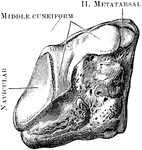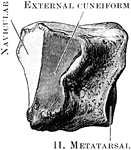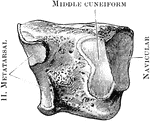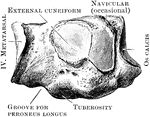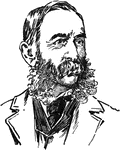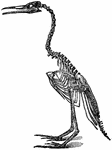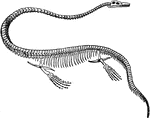
Metatarsal Bones
View of the bases and shafts of the second, third, and fourth metatarsal bones of the right foot.
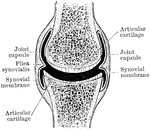
Diarthrodial Joint
Shown is a a diagram of a diarthrodial joint. In the diarthrodial group the extensive cavity has produced…
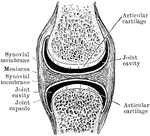
Diarthrodial Joint
In the diarthrodial group the extensive cavity has produced great interruption in the continuity of…
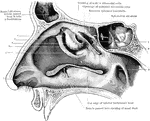
Outer Wall of Nose
View of the outer wall of the nose. The turbinated bones having been removed. Labels: 1, vestibule,…
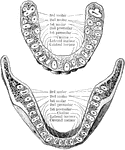
Jaw Showing Roots of Teeth
Horizontal section through both the upper and lower jaws to show the roots of the teeth. The sections…

Bear Foot
"Palmar aspect of left fore foot of a black bear (Ursus americanus). scl, scapholunar; c, cuneiform;…
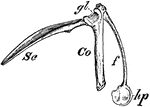
Bird Scapula
"Right shoulder-girdle or scapular arch of fowl, showing hp, the hypoclidium; f, furculum; Co, coracoid;…
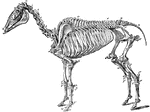
Skeleton of a Horse
The skeleton of a horse. Axial Skeleton. The Skull. Cranial Bones: a, occipital, 1; b, wormian, 1; c,…

Skeleton of a Horse
The skeleton of a horse. Showing its relation to the contour of the animal, viewed laterally. Labels:…

Bird Skull
"Schizognathous skull of common fowl. pmx, premaxilla; mxp, maxillopalatine; mx, maxilla; pl, palatine;…

Curlew Skull
"Schizorhinal skull of curlew (top view), showing the long cleft, a, between upper and lower forks of…

Longitudinal Section of Horse Skull
Longitudinal section of a horse's skull. Labels: 1, supraoccipital bone and crest; 2, parietal bone;…

Hyoid Series of Bones in a Horse
The hyoid series is composed of five distinct pieces- a body, or hyoid bone proper, two cornua or horns…
Horse Leg
External view of bones of right carpus, metacarpus, and digit of a horse. 1, distal end of radius; 2,…

Phalanges of a Horse
Posterior view of phalanges of a horse disarticulated. Labels: a, os suffraginis; b, os coronae; C,…

Tarsus of a Horse
Bones of left tarsus of a horse, seen from in front and outside. Labels: 1, calcaneum; 2, astragalus;…
Horse Leg
External view of bones of left tarsus, metatarsus, and digit of a horse. Labels: 1, distal end of tibia;…
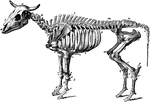
Ox Skeleton
The skeleton of an ox. Axial Skeleton. The skull. Cranial Bones- occipital, 1: b, parietal, 2; a, frontal,…
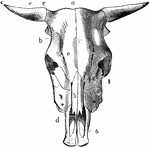
Ox Skull
Skull of an ox, superior aspect. Labels: a, frontal crest; b, lateral crest; c, horn core; d, nasal…

Skeleton of a Hog
Skeleton of the hog. Axial skeleton. The skull. Cranial bones- a, occipital, 1; b, parietal, 2; d, frontal,…
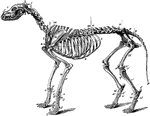
Skeleton of a Dog
The skeleton of the dog. Axial skeleton. The skull. Cranial bones- a, occipital, 1; b, parietal, 2;…
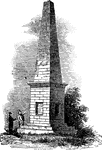
The Wyoming Monument
The Monument marks the grave site of the bones of victims of the Wyoming Massacre, which took place…
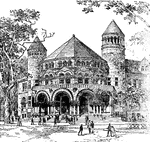
Osborn Hall, Yale University
Many buildings stood on the Old Campus which were removed to make way for the current configuration…
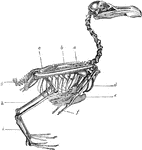
Skeleton of a Bird
The skeleton of a bird. Labels: a, radius and ulna; b, dorsal vertebrae; c, sacrum and pelvis; g, ploughshare…
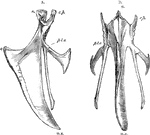
Sternum of a Bird
The sternum of a bird. Label: a, lateral aspect; b, inferior aspect; r, rostrum; c.p, costal process;…

Skull of a Bird
The skull of a bird. Labels: a, inferior aspect, the mandible being removed; b, lateral aspect; px,…
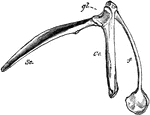
Pectoral Arch of a Bird
The pectoral arch of a bird. Labels: sc, scapula; co, coracoid bone; f, clavicle, terminating below…
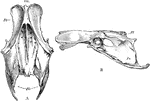
Pelvis of a Bird
The pelvis of a bird. Labels: a, superior; b, lateral aspect; sm, sacrum; Il, ilium; Is, ischium; Am,…

Saltwater Drum
Pogonias chromis, a name of several fish so called from the drumming noise they make, said to be due,…

Skull Head
This Skull Head was a design found on the shield of death, monuments, tombs and often represented over…
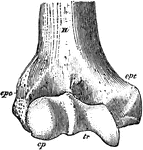
Humerus
"Anterior View, Distal End, of Right Humerus of a Man. H, humerus; epc, epicondyle, or external supracondyloid…

Bobolink Epipleurae
"Epipleurae.-- Thorax, scapular arch, and part of pelvic arch of a bobolink (Dolichonyx oryzivorus).…
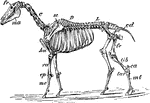
Horse Skeleton
"Skeleton of Horse (Equus caballus). fr, frontal bone; C, cervical vertebrae; D, dorsal vertebrae; L,…

Domestic Cat Skull
"Skull of Cat (Felis catus), showing the following bones, viz. : na, nasal; pm, premaxillary; m, maxillary;…

Bones of Human Foot
"Bones of Human Foot, or Pes, the third principal segment of the hind limb, consisting of tarsus, metatarsus,…

The Diagram of a Third Cervical Vertebra of a Woodpecker
"Third cervical vertebra of Woodpecker (Picus viridis). (Viewed anteriorly.) Ft, vertebrarterial foramen;…

The Skeleton of the Trunk of a Falcon
"Skeleton of the trunk of a Falcon. Ca, coracoid, which articulates with the sternum (St) at ; Cr, keel…
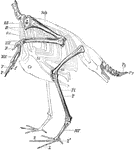
Skeleton of the Limbs and Tail of a Carinate Bird
"Skeleton of the Limbs and Tail of a Carinate Bird. (The skeleton of the body is indicated by dotted…

Diagram of the Pelvis of a Kiwi
"Pelvis of Apteryx austrlis. Lateral view. a, Acetabulum; il, ilium; is, ischium; p, pectineal process…

Diagram of the Skull of a Wild Duck
"Skull of a Wild Duck (Anus boscas), from the side. ag, Angular; als, alisphenoid; ar, articular; bt,…

Archaeopteryx Lithographica
"Archaeornithes is at present represented by but one member, the first undoubted fossil Bird, made known…
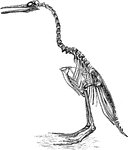
The Restoration of the Hesperornis Regalis
"Hesperornis regalis, (a fossilized restoration) which stood about three feet high, had blunt teeth…

Skeleton Head of a Ichthyornis
"Ichthyornis victor and I. dispar, ...were small forms of about the size of a Partridge, with the habits…

Bad Lands of Dakota
In the Dakotah (Dakota) Territory, the area know as the Bad Lands, is a sunken area thirty miles wide…

Bones of Elephant's Foot
Homology of digits of odd toed mammals, showing gradual reduction in number and consolidation of bones.…

Bones of Coney's Foot
Homology of digits of odd toed mammals, showing gradual reduction in number and consolidation of bones.…
